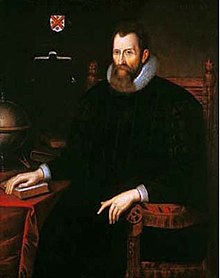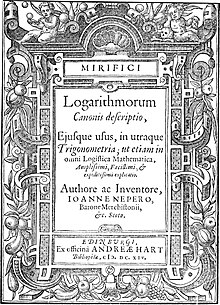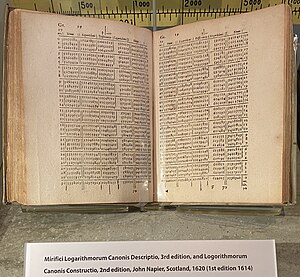User:ArnoldReinhold/sandbox/Mirifici Logarithmorum Canonis



Mirifici Logarithmorum Canonis Descriptio (Description of the Wonderful Canon of Logarithms, 1614 c.e.) and Mirifici Logarithmorum Canonis Constructio (Construction of the Wonderful Canon of Logarithms, 1619) are two books in Latin by John Napier expounding the method of logarithms. While others had approached the idea of logarithms, notably Jost Bürgi, it was Napier who first published the concept, along with easily used precomputed tables, in his Mirifici Logarithmorum Canonis Descriptio.[1][2][3]
Prior to the introduction of logarithms, high accuracy numerical calculations involving multiplication, division and root extraction were laborious and error prone. Logarithms greatly simplify such calculations. As Napier put it:
“…nothing is more tedious, fellow mathematicians, in the practice of the mathematical arts, than the great delays suffered in the tedium of lengthy multiplications and divisions, the finding of ratios, and in the extraction of square and cube roots… [with] the many slippery errors that can arise…I have found an amazing way of shortening the proceedings [in which]… all the numbers associated with the multiplications, and divisions of numbers, and with the long arduous tasks of extracting square and cube roots are themselves rejected from the work, and in their place other numbers are substituted, which perform the tasks of these rejected by means of addition, subtraction, and division by two or three only.”[2]: Preface
The book contains fifty-seven pages of explanatory matter and ninety pages of tables of trigonometric functions and their natural logarithms. These tables greatly simplified calculations in spherical trigonometry, which are central to astronomy and celestial navigation and which typically include products of sines, cosines and other functions. Napier described other uses, such a solving ratio problems, as well.[2]: Preface
John Napier spent 20 years calculating the tables.[4]: p. 16 He wrote a separate volume describing how he constructed his tables, but held off publication to see how his first book would be received. John died in 1617. His son, Robert, published his father's book, with additions by Henry Briggs in 1619.[5]
The tables[edit]
In Napier’s time, decimal notation, as used in Europe, only represented integers. The idea of including a fractional part with a decimal number had been proposed by Simon Stevin but his notation was awkward. The idea of using a period to separate the integer part of a decimal number from the fractional part was first proposed by Napier himself in his Constrictio book, Paragraph 5 Note: “In numbers distinguished thus by a period in their midst, whatever is written after the period is a fraction, the denominator of which is unity with as many cyphers after it as there are figures after the period.“ but he used the concept to facilitate more accurate computation of the tables, but not in the tables themselves..[1]: p. 22
Thus the sine values published in his table represent the integer length of the side opposite a given angle in a right triangle with hypotenuse of 10,000,000 units. The logarithms in the table, however, are of the sine value divided by 10,000,000..[1]: p. 19 For example XXX They are again treated as an integer with an implied denominator of 10,000,000.
The table consists of 45 pairs facing pages. Each pair is labeled at the top with an angle, from 0 to 44 degrees, and at the bottom from 90 to 45 degrees. (The 44 - 45 degree page being a single side.) The column 1 on each page of the table is an angle increment in minutes, to be added to the degree value at the top of the page. The far right column is in minutes but to be added to the degree value at the bottom of each page. This arrangement is such that for each line on a page, the full angle represented by column 7 is the co-angle of column 1 (90° - column_1). Moving inward, adjacent to each angle column is the sine of that angle, followed by the absolute value of natural log of that sine. One can get log-cosines for column 1 easily by reading across the page to column 5, and vice versa. In the middle column is the difference between the two logs, which is, the natural log of the tangent function (cotangent if you reverse signs).[2]: Ch. III
The tables can also be used as a table of natural logarithms for positive numbers less than one, using the sine values (Columns 2 and 6) as the argument and the log sine values (Columns 3 and 5) as the resulting logarithm. Reversing the procedure give anitlogarithms
The first three rows in the table below reproduce the headings and first two data rows of the left-side 19 degree page of Napier's table, see photograph. They are followed by values computed using modern algorithms for the same angles.[5] These are truncated to 8-digit accuracy, one more than the nominal 7-digit accuracy of the original. Column numbers are included for clarity.
| mi. | Sinus | Logarithmi | Differentie | Logarithmi | Sinus | |
|---|---|---|---|---|---|---|
| 0 | 3255682 | 11221830 | 10661613 | 560217 | 9455186 | 60 |
| 1 | 3258432 | 11213386 | 10652167 | 561219 | 9454239 | 59 |
| θ | sin(θ) | -ln(sin(θ)) | -ln(tan(θ)) | -ln(sin(90°-θ)) | sin(90°-θ) | 90°-θ |
| 19° | .32556815 | 1.12218345 | 1.0661617 | .05602174 | .94551857 | 71° |
| 19° 1' | .32584318 | 1.12133905 | 1.0652171 | .05612195 | .94542383 | 70° 59' |
| Column 1 | 2 | 3 | 4 | 5 | 6 | 7 |
The Descriptio text[edit]
Napier describes his invention in two books.
Book I[edit]
Chapter 1 contains a series of definitions and propositions that explains his conception of logarithms. He conceived logarithms in terms of two models of motion. In the first, a particle starts at a point and moves along a straight line at a constant speed. In the second, a particle moves along a straight line, starting with the same initial speed, but its speed decreases in proportion to its distance from the starting point.: Ch. I, Def. 2 The logarithm of a number, a, is then the distance traveled by a particle in the constant speed model, during the time it takes the particle in the second, inverse proportional model to reach a.[2]: Ch. I, Def. 6 He defines the logarithm of 10,000,000 to be zero and that the logarithm of values less than that to be positive, while greater numbers have a negative logarithm, a reversal of sign from modern logarithms, He notes that he has freedom to choose any value to a zero log, in modern terms the base, but chooses 10,000,000 for ease of calculation as it matches the "total sine" ( the hypotenuse, in his sine tables. See Naperian logarithm.
The second chapter describes the properties of logarithms and give some formulas (in text form) for working with ratios. It ends with a note stating he is delaying publication of his work on construction logarithms until he sees how is invention is received. Chapter 3 describes the tables and their seven columns, see above. The fourth chapter explains how to use the tables and gives worked examples for sines tangents and secants. He also explains how to get logarithms of numbers directly by using the sine values as the argument and the log-sine values as result and vice versa. He discusses how to deal with different multiples of ten and introduces a notation, similar to modern scientific notation where he appends a number of zeros after the logarithm of a quantity to indicate a need for correction by decades. He give specific logarithm quantities to be added or subtracted in different cases:
- 23025842 + 0 or 46051684 + 00, or 69077527 + 000, or 92103369 + 0000, or 115129211 + 00000
Chapter 5 presents four problems in proportionality and their solution using Napier's logarithms. He concludes by ask the reader to judge "how great a benefit is bestowed by these logarithms : since by the addition of these for multiplication, by subtraction for divisional, by division by two for the extraction of square roots, and by three for cube roots ... all the heavier work of calculation is avoided." He promises to discuss in Book II.
Book II[edit]
Book II deals with "that noble kind of Geometry, that is called Trigonometry." The first chapter deals with using logarithms to solve problems in plane trigonometry with right triangles and, in particular, with small angles, where his trigonometric logarithms become large. The next chapter cover plane oblique triangles. The remaining chapters cover spherical trigonometry, starting with quadrants.
Mirifici Logarithmorum Canonis Constructio[edit]
Napier was reluctant to publish the theory and details of how he created his table of logarithms pending feedback from the mathematics community on his ideas. But he died shortly after publication of the discriptio. His son Robert published the constructio in 1619. The volume included a section on John Napier’s methods for more easily solving spherical triangles, and a section by Henry Biggs on “another and better kind of logarithms,” namely base 10 or common logarithms.
The book begins with a preface by Robert. Napier‘s starts by describing logarithms as numbers picked out from a geometric progression, and points out that high accuracy is required. He achieves this by first starting with a large base of 10,000,000. He then gets additional precision by using decimal fractions in a notation that he invented, but now universally familiar, namely using a decimal point. He goes on to explain how his notation works with some examples. He then introduces a form of interval arithmetic to bound any errors that might still occur in his calculations.[4]: p. 8
Auxiliary tables[edit]
To support his construction of the logarithms, he fist builds three tables of proportional numbers. He points out that while creating a geometrical progression is hard in general, it can be easier if the offset from unity is small.: Sec 16 The first table, in modern notation, consists of the numbers 10000000*(0.9999999)n for n ranging from 0 to 100. The second consists of the numbers 100000*(0.99999)n for n ranging from 0 to 50. An error crept into his calculations of the second table; his fiftieth value is 9995001.222927, but should be 9995001.22480.[6]: p.14
He then constructs a third table of proportions with 69 columns and 21 rows. The columns are in proportion 0.9995, the rows 0.99. After computing the logarithm of a few key values, he can fill in the logarithm of each entry in the third table because, by proportionality, the difference in logarithms between entries is constant.[6]: p.33 The third table now provides logarithms for a set of values that cover the range from roughly 5,000,000 to 10,000,000, which corresponds to values the sine function from 30 to 90 degrees, assuming a radius of 10,000,000.[4]: p. 7 Napier then explains how to use the tables to calculate a bounding interval for logarithm in that range.
Napier then gives instructions for reproducing his tables with their seven columns and coverage of each minute of ark. He does not compute the sines themselves,The values for sines are filled in from already available tables. "Reinhold's common table of sines, or any other more exact, will supply you with these values."[6]: Sec. 59
Reception[edit]
Napier's novel method of calculation spread quickly in Britain and abroad. Kepler dedicated his 1620 Ephereris to Napier, with a letter congratulating him on his invention and its benefits to astronomy. Keppler found no essential errors except for some inaccuracies at small angles.[1]: p. 16
In 1620 Edmund Gunter developed a ruler with a logarithmic scale; with a pair of dividers it could be used to multiply and divide.[7] In c. 1622, William Oughtred combined two handheld Gunter rules to make a calculating device that was essentially the first slide rule.[8]
See also[edit]
References[edit]
- ^ a b c d Ernest William Hobson (1914), John Napier and the invention of logarithms, 1614, Cambridge: The University Press
- ^ a b c d e Napier, John (1614). The Description of the Wonderful Canon of Logarithms (PDF). Translated by Wright, Edward; Bruce, Ian. 17centurymaths.com. Retrieved March 14, 2022.
- ^ Napier, John (1614), Mirifici Logarithmorum Canonis Descriptio [The Description of the Wonderful Rule of Logarithms] (in Latin), Edinburgh, Scotland: Andrew Hart
- ^ a b c Roegel, Denis (2012). "Napier's ideal construction of the logarithms". HAL. INRIA. Retrieved 13 March 2022.
from the Loria Collection of Mathematical Tables
- ^ a b Napier, John (1889) [1620]. The Construction of the Wonderful Canon of Logarithms (PDF). Translated by Macdonald, William Rae. Edinburgh: Blackwood & Sons – via Internet Archive.
- ^ a b c Cite error: The named reference
constructionIAwas invoked but never defined (see the help page). - ^ Smith, David E. (1958). History of Mathematics. Courier Corporation. p. 205. ISBN 9780486204307.
- ^ Applebaum, Wilbur (2003-12-16). "Slide Rule". Encyclopedia of the Scientific Revolution: From Copernicus to Newton. Routledge. Bibcode:2000esrc.book.....A. ISBN 9781135582555.
Category:Logarithms]]
